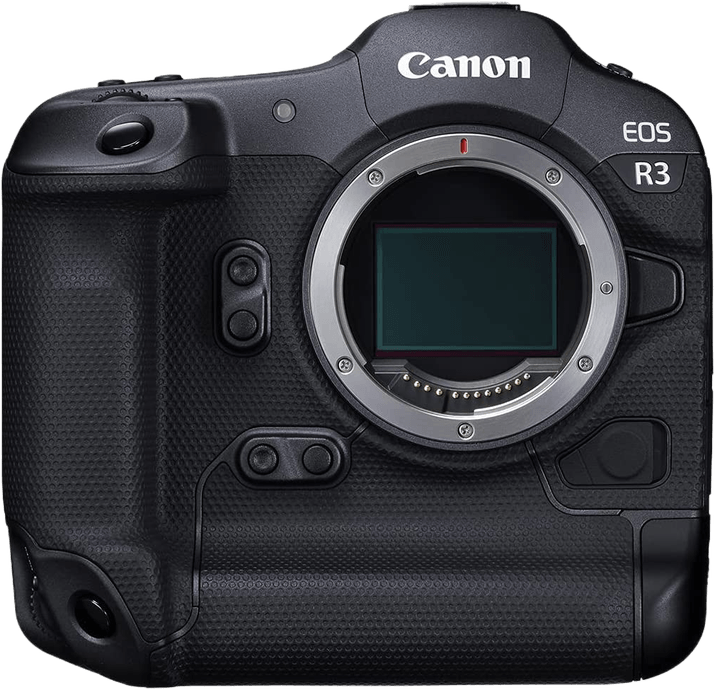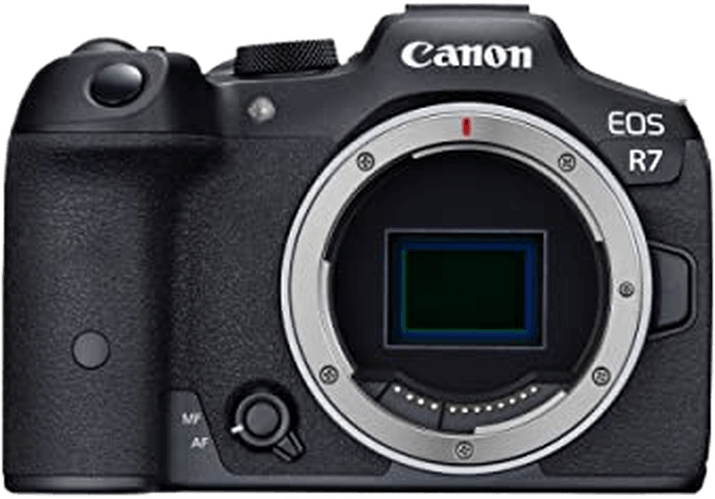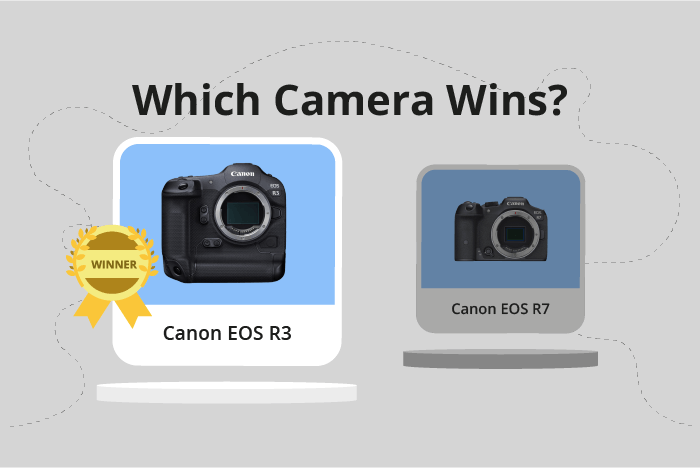Canon EOS R3 vs EOS R7 Comparison
Canon EOS R3

Canon EOS R7

The Canon EOS R3 outperforms the Canon EOS R7 with a score of 84/100, compared to the R7’s 83/100. Both cameras are mirrorless and were released within a year of each other, with the R3 launching in 2021 and the R7 in 2022. They share similarities in their camera type and release years.
The EOS R3 excels with its larger size (150 x 143 x 87mm) and heavier weight (1015g / 2.24lbs), which can provide better stability and handling for professional photographers. However, the Canon EOS R7 has its advantages, such as a significantly lower launch price of $1500, compared to the R3’s $5999. The R7 is also more compact (132 x 90 x 92mm) and lighter (612g / 1.35lbs), making it a more portable option for casual photographers.
Taking these factors into account, the Canon EOS R3 is a superior camera for professionals seeking better handling and stability, while the Canon EOS R7 offers a more affordable and portable option for casual users.
Canon EOS R3 vs EOS R7 Overview and Optics
The Canon EOS R3 outperforms the Canon EOS R7 in optics with a score of 84/100 compared to the R7’s 82/100. Both cameras share several specifications, including a CMOS sensor, Digic X processor, Canon RF lens mount, and image stabilization. However, the R3 surpasses the R7 in certain aspects, while the R7 has its advantages as well.
The R3’s superior shooting speed of 30 frames per second (fps) compared to the R7’s 15 fps allows for capturing fast-moving subjects with ease. This feature makes the R3 a better choice for action and sports photography. Additionally, the R3’s full-frame sensor provides better low-light performance and increased dynamic range compared to the R7’s APS-C sensor.
On the other hand, the R7 boasts a higher resolution with 33 megapixels, compared to the R3’s 24 megapixels, resulting in more detailed images. This advantage makes the R7 more suitable for landscape and portrait photography, where high resolution is crucial. Moreover, the R7’s DXOMARK score for the sensor is 97, slightly higher than the R3’s score of 96, indicating a marginally better sensor performance.
Taking these factors into account, the Canon EOS R3 stands out as the winner in terms of optics due to its faster shooting speed and full-frame sensor. However, the Canon EOS R7 is not without its merits, particularly in high-resolution photography. Ultimately, the choice between the two cameras depends on the specific requirements and preferences of the photographer.
Canon EOS R3 vs EOS R7 Video Performance
The Canon EOS R3 outperforms the Canon EOS R7 in video capabilities with a video score of 96/100, compared to the R7’s score of 91/100. Both cameras share some common specifications, such as a maximum video frame rate of 120fps and built-in time-lapse functionality. However, differences in video resolution and dimensions set them apart.
The EOS R3 excels with a maximum video resolution of 6K and dimensions of 6000 x 3164, providing superior image quality and detail compared to the R7. This advantage makes the R3 a more suitable choice for professional videographers and filmmakers who require high-resolution footage.
On the other hand, the EOS R7 has a maximum video resolution of 4K with dimensions of 3840 x 2160. While this is lower than the R3, it is still an excellent choice for many users, particularly those who prioritize a balance between video quality and file size. The 4K resolution is more than sufficient for most applications, such as vlogging, online content creation, and casual videography.
Considering these points, the Canon EOS R3 is the clear winner in terms of video capabilities due to its higher resolution and larger dimensions. This makes it the ideal option for professionals and enthusiasts seeking the best possible video quality. Meanwhile, the Canon EOS R7 remains a strong contender and a more budget-friendly alternative, offering reliable performance for a wide range of users with its 4K capabilities.
Canon EOS R3 vs EOS R7 Features and Benefits
The Canon EOS R3 wins the features comparison with a score of 87/100, while the Canon EOS R7 scores 85/100. Both cameras share several specifications, including touchscreen functionality, flip screens, WIFI, and Bluetooth connectivity.
The winning Canon EOS R3 outperforms the EOS R7 with its larger screen size of 3.2 inches and a higher screen resolution of 4,150,000 dots. This larger and higher-resolution screen provides better image preview and easier menu navigation. Additionally, the EOS R3 includes GPS functionality, which is absent in the EOS R7. This GPS feature allows photographers to geotag their photos, making it beneficial for travel and landscape photography.
On the other hand, the Canon EOS R7, despite scoring lower, still offers reliable performance with its 3-inch touchscreen and 1,620,000-dot screen resolution. While its screen is smaller and less sharp than the EOS R3, it remains functional for reviewing images and navigating menus. It also shares the same flip screen, WIFI, and Bluetooth features as the EOS R3.
The EOS R3’s larger, higher-resolution screen and GPS functionality make it the superior choice for photographers seeking advanced features and improved usability. However, the EOS R7 remains a competent option for those who prioritize affordability and can manage without GPS or a larger screen. Both cameras provide quality performance, but the EOS R3’s additional features give it the edge in this comparison.
Canon EOS R3 vs EOS R7 Storage and Battery
The Canon EOS R3 outperforms the Canon EOS R7 in storage and battery with a score of 81/100 compared to 79/100. Both cameras share common features, such as two memory card slots and USB charging capabilities. They accept SD, SDHC, and SDXC memory cards, with the R3 also supporting CFexpress Type B cards and UHS-II compatibility.
The R3’s superior battery life of 760 shots, compared to the R7’s 660 shots, gives it an edge. Its battery type, LP-E19, contributes to this advantage. On the other hand, the R7 uses an LP-E6NH battery, which results in a slightly shorter battery life. Despite its lower score, the R7 still offers decent performance in this aspect.
While the R3 is the winner in storage and battery, the R7 remains a solid choice for photographers who prioritize other features. Both cameras provide reliable performance, and the differences in storage and battery should be weighed against individual preferences and requirements.
Alternatives to the Canon EOS R3 and EOS R7
Are you still undecided about which camera is right for you? Have a look at these popular comparisons that feature the Canon EOS R3 or the Canon EOS R7:

